高二英语Firstaid知识点整理
- 格式:docx
- 大小:19.76 KB
- 文档页数:8
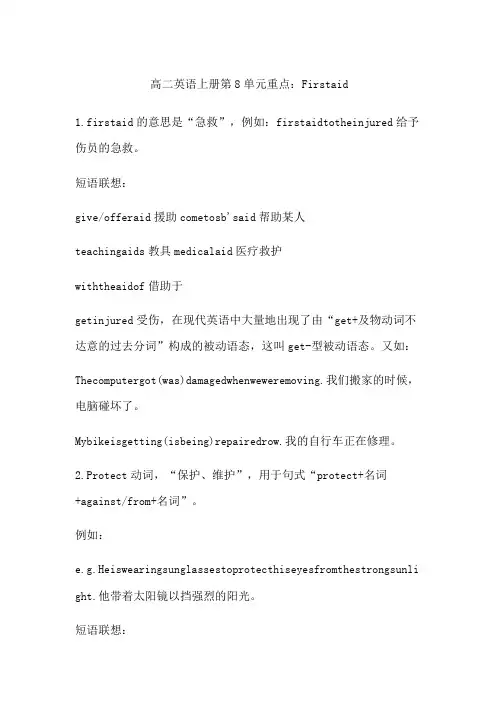
高二英语上册第8单元重点:Firstaid1.firstaid的意思是“急救”,例如:firstaidtotheinjured给予伤员的急救。
短语联想:give/offeraid援助cometosb'said帮助某人teachingaids教具medicalaid医疗救护withtheaidof借助于getinjured受伤,在现代英语中大量地出现了由“get+及物动词不达意的过去分词”构成的被动语态,这叫get-型被动语态。
又如:Thecomputergot(was)damagedwhenweweremoving.我们搬家的时候,电脑碰坏了。
Mybikeisgetting(isbeing)repairedrow.我的自行车正在修理。
2.Protect动词,“保护、维护”,用于句式“protect+名词+against/from+名词”。
例如:e.g.Heiswearingsunglassestoprotecthiseyesfromthestrongsunli ght.他带着太阳镜以挡强烈的阳光。
短语联想:Keep...from...不让/避免stop...(from)...阻止prevent...(from)...妨碍/防止disable...from...使……失去(能力/资格)save...from...挽救、拯救3.dependon取决于。
例如:e.g.Theamountyoupaydependsonwhereyoulive.你付多少取决于你住哪里。
词义拓展dependon依靠,依赖:Hisfamilydependsonhim.他的一家人全靠他养活。
依赖,信任:WearedependingonyoutofinishthejobbyFriday.我们相信你在星期五前能完成这项工作。
4.squeeze动词,意思是“榨取”、“挤出”,例如:squeezeanorange榨橘子常用句式squeeze+名词+out(of/from)+名词,例如:e.g.Thoseblackmailersintendedtosqueezemoremoneyoutofhim.那些勒索者打算向他榨取更多的钱。
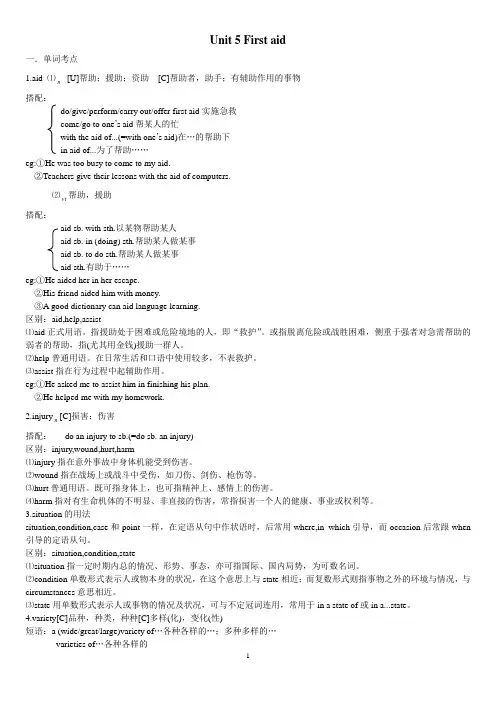
Unit 5 First aid一.单词考点[U]帮助;援助;资助[C]帮助者,助手;有辅助作用的事物1.aid ⑴n搭配:do/give/perform/carry out/offer first aid实施急救come/go to one’s aid帮某人的忙with the aid of...(=with one’s aid)在…的帮助下in aid of...为了帮助……eg:①He was too busy to come to my aid.②Teachers give their lessons with the aid of computers.⑵帮助,援助vt搭配:aid sb. with sth.以某物帮助某人aid sb. in (doing) sth.帮助某人做某事aid sb. to do sth.帮助某人做某事aid sth.有助于……eg:①He aided her in her escape.②His friend aided him with money.③A good dictionary can aid language learning.区别:aid,help,assist⑴aid正式用语。
指援助处于困难或危险境地的人,即“救护”。
或指脱离危险或战胜困难,侧重于强者对急需帮助的弱者的帮助,指(尤其用金钱)援助一群人。
⑵help普通用语。
在日常生活和口语中使用较多,不表救护。
⑶assist指在行为过程中起辅助作用。
eg:①He asked me to assist him in finishing his plan.②He helped me with my homework.[C]损害;伤害2.injuryn搭配:do an injury to sb.(=do sb. an injury)区别:injury,wound,hurt,harm⑴injury指在意外事故中身体机能受到伤害。
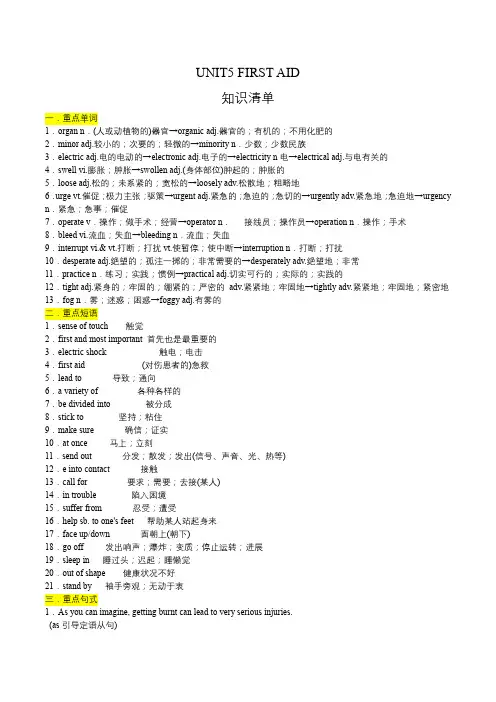
UNIT5 FIRST AID知识清单一.重点单词1.organ n.(人或动植物的)器官→organic adj.器官的;有机的;不用化肥的2.minor adj.较小的;次要的;轻微的→minority n.少数;少数民族3.electric adj.电的电动的→electronic adj.电子的→electricity n电→electrical adj.与电有关的4.swell vi.膨胀;肿胀→swollen adj.(身体部位)肿起的;肿胀的5.loose adj.松的;未系紧的;宽松的→loosely adv.松散地;粗略地6.urge vt.催促;极力主张;驱策→urgent adj.紧急的;急迫的;急切的→urgently adv.紧急地;急迫地→urgency n.紧急;急事;催促7.operate v.操作;做手术;经营→operator n.接线员;操作员→operation n.操作;手术8.bleed vi.流血;失血→bleeding n.流血;失血9.interrupt vi.& vt.打断;打扰vt.使暂停;使中断→interruption n.打断;打扰10.desperate adj.绝望的;孤注一掷的;非常需要的→desperately adv.绝望地;非常11.practice n.练习;实践;惯例→practical adj.切实可行的;实际的;实践的12.tight adj.紧身的;牢固的;绷紧的;严密的adv.紧紧地;牢固地→tightly adv.紧紧地;牢固地;紧密地13.fog n.雾;迷惑;困惑→foggy adj.有雾的二.重点短语1.sense of touch触觉2.first and most important 首先也是最重要的3.electric shock 触电;电击4.first aid (对伤患者的)急救5.lead to 导致;通向6.a variety of 各种各样的7.be divided into 被分成8.stick to 坚持;粘住9.make sure 确信;证实10.at once 马上;立刻11.send out 分发;散发;发出(信号、声音、光、热等)12.e into contact 接触13.call for 要求;需要;去接(某人)14.in trouble 陷入困境15.suffer from 忍受;遭受16.help sb. to one's feet 帮助某人站起身来17.face up/down 面朝上(朝下)18.go off 发出响声;爆炸;变质;停止运转;进展19.sleep in 睡过头;迟起;睡懒觉20.out of shape 健康状况不好21.stand by 袖手旁观;无动于衷三.重点句式1.As you can imagine, getting burnt can lead to very serious injuries.(as引导定语从句)正如你能想象的,被灼烧可能会导致非常严重的损伤2.Remove any clothes using scissors if necessary, unless you see the fabric sticking to the burnt skin.(if省略结构)除非衣服粘贴在烧伤的皮肤上,否则都要清除,必要时可使用剪刀。
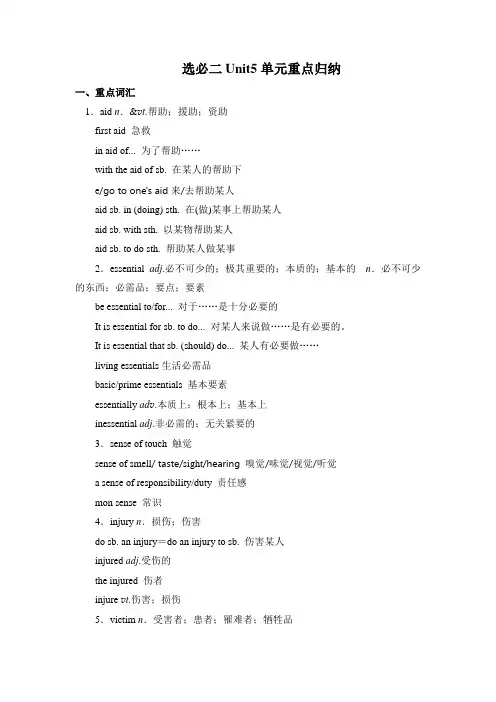
选必二Unit5单元重点归纳一、重点词汇1.aid n.&v t.帮助;援助;资助first aid 急救in aid of... 为了帮助……with the aid of sb. 在某人的帮助下e/go to one's aid来/去帮助某人aid sb. in (doing) sth. 在(做)某事上帮助某人aid sb. with sth. 以某物帮助某人aid sb. to do sth. 帮助某人做某事2.essential adj.必不可少的;极其重要的;本质的;基本的n.必不可少的东西;必需品;要点;要素be essential to/for... 对于……是十分必要的It is essential for sb. to do... 对某人来说做……是有必要的。
It is essential that sb. (should) do... 某人有必要做……living essentials生活必需品basic/prime essentials 基本要素essentially ad v.本质上;根本上;基本上inessential adj.非必需的;无关紧要的3.sense of touch 触觉sense of smell/ taste/sight/hearing 嗅觉/味觉/视觉/听觉a sense of responsibility/duty 责任感mon sense 常识4.injury n.损伤;伤害do sb. an injury=do an injury to sb. 伤害某人injured adj.受伤的the injured 伤者injure v t.伤害;损伤5.victim n.受害者;患者;罹难者;牺牲品accident/earthquake victims事故/地震的罹难者AIDS/cancer victims艾滋病/癌症患者fall victim to... 成为……的牺牲品/受害者6.urgent adj.紧急的;急迫的;急切的urge v.力劝;敦促;强烈要求n.强烈的愿望urge sb. on 鼓励某人;为某人加油urge sb. to do sth. 敦促某人做某事urge sth. on/upon sb. 极力主张某人某事;向某人敦促某事urge that... 主张……It is urged that... (should) do sth. 坚决要求……做某事。
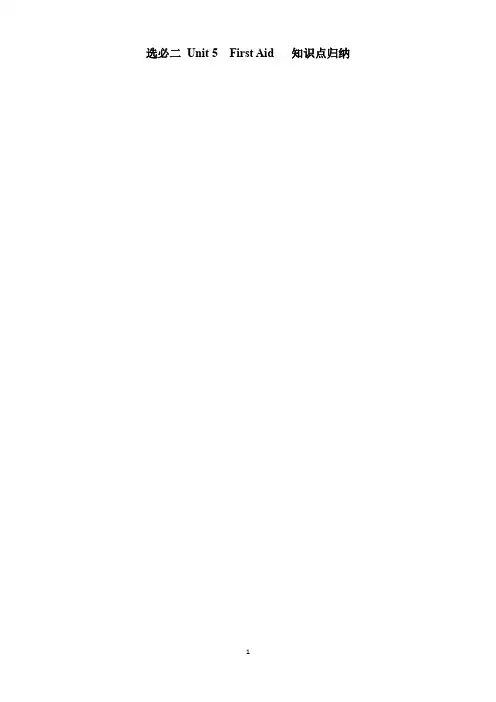
选必二Unit 5 First Aid 知识点归纳1Words and phrases:1.technique n.技能;技术;技艺;(具体的某种技术和技巧) [C]technology n.技术;工艺较广泛,尤指生产工艺;科学技术[U]technical adj.技术的; 工艺的technical supporttechnician n. 技师;技术人员first aid techniques 急救技能science and technology 科学技术2.leaflet n. 散页印刷品;传单;小册子brochure n. 资料(或广告)手册a leaflet on local places of interest 关于当地旅游胜地的一个小册子hand out/ give out leaflets 分发传单an n.(人或动植物的)器官organic adj.器官的;有机的organically adv. 有机地organism n. 生物,有机体organ donation 器官捐赠organic rejection/farming 器官排异/有机耕作4.ray n.光线; 光束; (热、电等的)射线a ray of sunshine一缕阳光A brave man will not be defeated as long as there is a ray of hope .5.sense n.感官;感觉;意义sense of sight/smell/hearing/touch/taste 视/嗅/听/触/味觉;a sense of responsibility/humour/security 责任/幽默/安全感The blind have a keen/sharp sense of hearing. 盲人有着敏锐的听觉。
make (no) sense (没)有意义、讲(不)得通make sense of 理解in a sense 从某种意义上说in no sense 绝不There is no sense (in) doing sth. 做某事没有意义6.minor adj.较小的;次要的;轻微的vi.辅修n.辅修科目minor injuries 轻伤minor in 辅修...minority n.少数;少数民族a minority of 少量的;少数的be in a/the minority 占少数比较:major/majority7.electric adj.电的;用电的;电动的(用电操作的或者生电的) electric shock /an electric fan/carelectrical adj.电的; 电气的(与电有关的人或事物) an electrical engineer electronic adj.电子的an electronic watchelectricity n.电/电流8.victim n. 受害者;患者 a victimfall victim to sth 受某物的伤害She fell victim to his sweet lies. 她曾受过他的甜言蜜语的蛊惑。
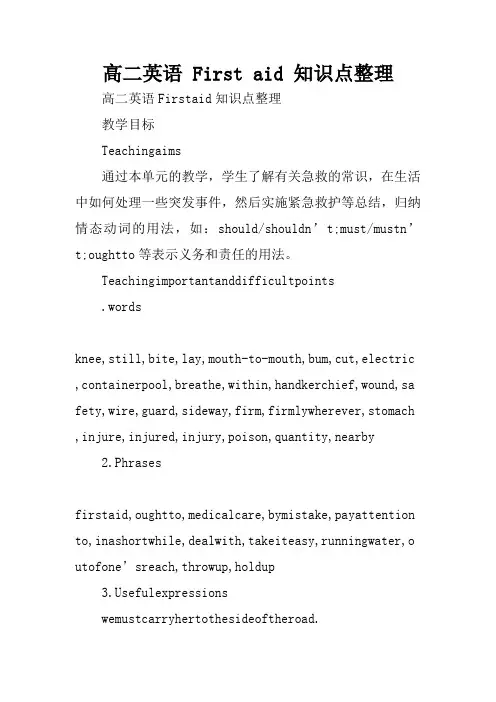
高二英语 First aid 知识点整理高二英语Firstaid知识点整理教学目标Teachingaims通过本单元的教学,学生了解有关急救的常识,在生活中如何处理一些突发事件,然后实施紧急救护等总结,归纳情态动词的用法,如:should/shouldn’t;must/mustn’t;oughtto等表示义务和责任的用法。
Teachingimportantanddifficultpoints.wordsknee,still,bite,lay,mouth-to-mouth,bum,cut,electric ,containerpool,breathe,within,handkerchief,wound,sa fety,wire,guard,sideway,firm,firmlywherever,stomach ,injure,injured,injury,poison,quantity,nearby2.Phrasesfirstaid,oughtto,medicalcare,bymistake,payattention to,inashortwhile,dealwith,takeiteasy,runningwater,o utofone’sreach,throwup,holdupefulexpressionswemustcarryhertothesideoftheroad.youmustn’tmovesomeoneiftheyarebadlyhurt.Parentsshouldknowsomefirstaid.youshouldn’tgetupifyouarebadlyhurt.Ioughttogohome.Ihavetocooksupperformygrandmother.4.GrammarRevisemodalVerbs:must,shouldStudymodalVerb:oughtto教学建议课文建议教师安排中国学习联盟声朗读课文,理解课文含义,通过阅读,教师对学生可小组讨论,提问,口语练习,复述急救方法等,教师给学生展示几组图片,帮助学生学会一般的急救措施和家庭安全常识。
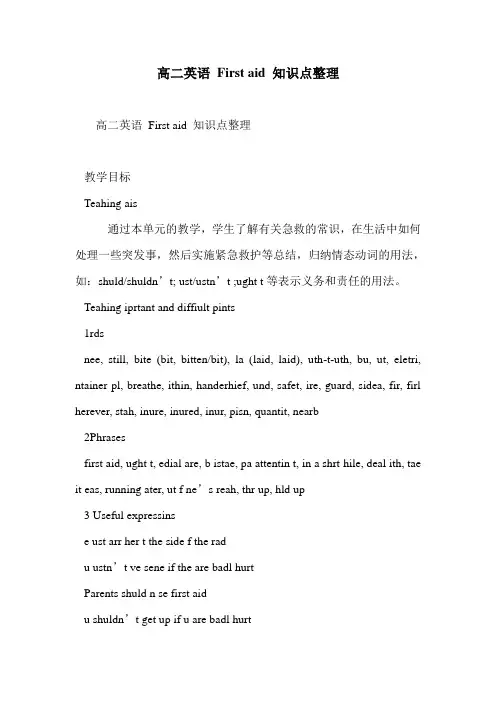
高二英语First aid 知识点整理高二英语First aid 知识点整理教学目标Teahing ais通过本单元的教学,学生了解有关急救的常识,在生活中如何处理一些突发事,然后实施紧急救护等总结,归纳情态动词的用法,如:shuld/shuldn’t; ust/ustn’t ;ught t等表示义务和责任的用法。
Teahing iprtant and diffiult pints1rdsnee, still, bite (bit, bitten/bit), la (laid, laid), uth-t-uth, bu, ut, eletri, ntainer pl, breathe, ithin, handerhief, und, safet, ire, guard, sidea, fir, firl herever, stah, inure, inured, inur, pisn, quantit, nearb2Phrasesfirst aid, ught t, edial are, b istae, pa attentin t, in a shrt hile, deal ith, tae it eas, running ater, ut f ne’s reah, thr up, hld up3 Useful expressinse ust arr her t the sidef the radu ustn’t ve sene if the are badl hurtParents shuld n se first aidu shuldn’t get up if u are badl hurtI ught t g heI have t supper fr grandther4 GraarRevise dal Verbs : ust, shuldStud dal Verb: ught t教学建议建议教师安排中国学习联盟声朗读,理解含义,通过阅读,教师对学生可小组讨论,提问,口语练习,复述急救方法等,教师给学生展示几组图片,帮助学生学会一般的急救措施和家庭安全常识。
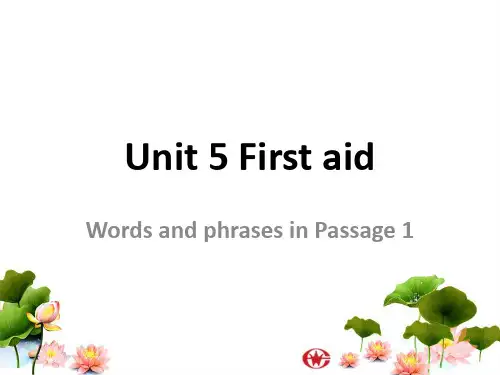
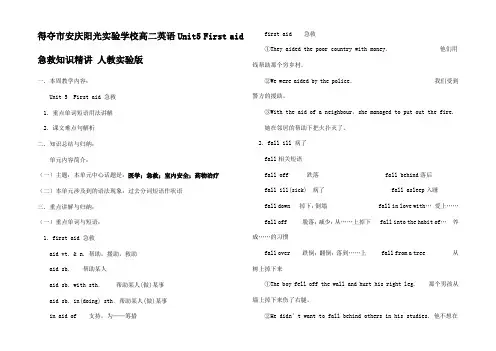
得夺市安庆阳光实验学校高二英语Unit5 First aid 急救知识精讲人教实验版一. 本周教学内容:Unit 5 First aid 急救1. 重点单词短语用法讲解2. 课文难点句解析二. 知识总结与归纳:单元内容简介:(一)主题:本单元中心话题是:医学;急救;室内安全;药物治疗(二)本单元涉及到的语法现象:过去分词短语作状语三. 重点讲解与归纳:(一)重点单词与短语:1. first aid 急救aid vt. & n. 帮助,援助,救助aid sb. 帮助某人aid sb. with sth.帮助某人(做)某事aid sb. in(doing) sth.帮助某人(做)某事in aid of 支持,为……筹措first aid 急救①They aided the poor country with money.他们用钱帮助那个穷乡村。
②We were aided by the police.我们受到警方的援助。
③With the aid of a neighbour,she managed to put out the fire.她在邻居的帮助下把火扑灭了。
2. fall ill 病了fall相关短语fall off 跌落 fall behind落后fall ill(sick) 病了 fall asleep入睡fall down 掉下;倒塌 fall in love with…爱上……fall off 脱落;减少;从……上掉下 fall into the habit of…养成……的习惯fall over 跌倒;翻倒;落到……上 fall from a tree 从树上掉下来①The boy fell off the wall and hurt his right leg. 那个男孩从墙上掉下来伤了右腿。
②He didn’t want to fall behind others in his studies. 他不想在学习上落后于别人。
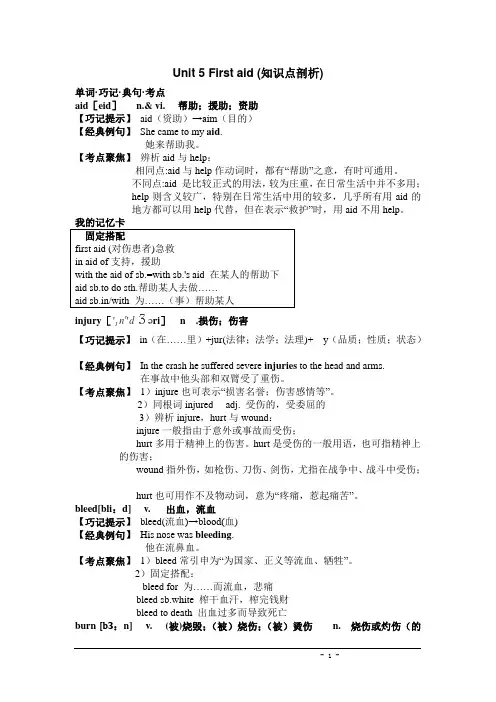
Unit 5 First aid (知识点剖析)单词·巧记·典句·考点aid [eid ] 帮助;援助;资助【巧记提示】 aid (资助)→aim (目的)【经典例句】 She came to my aid她来帮助我。
【考点聚焦】 辨析aid 与help :相同点:aid 与help 作动词时,都有“帮助”之意,有时可通用。
不同点:aid 是比较正式的用法,较为庄重,在日常生活中并不多用;help 则含义较广,特别在日常生活中用的较多,几乎所有用aid 的地方都可以用help 代替,但在表示“救护”时,用aid 不用help 。
固定搭配first aid (对伤患者)急救 in aid of 支持,援助with the aid of sb.=with sb.'s aid 在某人的帮助下aid sb.to do sth.帮助某人去做injury [d nI '' ri ]损伤;伤害【巧记提示】 in (在……里)+jur(法律;法学;法理(品质;性质;状态)【经典例句】 In the crash he suffered severe injuries在事故中他头部和双臂受了重伤。
【考点聚焦】 1)injure 也可表示“损害名誉;伤害感情等”。
2)同根词受伤的,受委屈的3)辨析injure ,hurt 与wound :injure 一般指由于意外或事故而受伤;hurt 多用于精神上的伤害。
hurt 是受伤的一般用语,也可指精神上的伤害;wound 指外伤,如枪伤、刀伤、剑伤,尤指在战争中、战斗中受伤;hurt 也可用作不及物动词,意为“疼痛,惹起痛苦”。
bleed[bli :出血,流血【巧记提示】 bleed(流血)→blood(血【经典例句】 His nose was bleeding .他在流鼻血。
【考点聚焦】 1)bleed 常引申为“为国家、正义等流血、牺牲”。
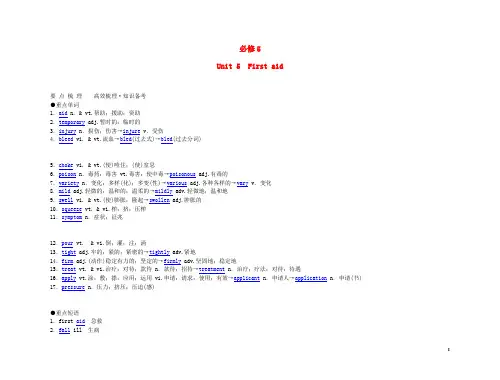
必修5Unit 5 First aid要点梳理高效梳理·知识备考●重点单词1.aid n. & vt.帮助;援助;资助2.temporary adj.暂时的;临时的3.injury n.损伤;伤害→injure v.受伤4.bleed vi. & vt.流血→bled(过去式)→bled(过去分词)5.choke vi. & vt.(使)噎住;(使)窒息6.poison n.毒药;毒害 vt.毒害;使中毒→poisonous adj.有毒的7.variety n.变化;多样(化);多变(性)→various adj.各种各样的→vary v.变化8.mild adj.轻微的;温和的;温柔的→mildly adv.轻微地;温和地9.swell vi. & vt.(使)膨胀;隆起→swollen adj.肿胀的10.squeeze vt. & vi.榨;挤;压榨11.symptom n.症状;征兆12.pour vt. & vi.倒;灌;注;涌13.tight adj.牢的;紧的;紧密的→tightly adv.紧地14.firm adj.(动作)稳定有力的;坚定的→firmly adv.坚固地;稳定地15.treat vt. & vi.治疗;对待;款待 n.款待;招待→treatment n.治疗;疗法;对待;待遇16.apply vt.涂;敷;搽;应用;运用 vi.申请;请求;使用;有效→applicant n.申请人→application n.申请(书) 17.pressure n.压力;挤压;压迫(感)●重点短语1.first aid急救2.fall ill 生病3.prevent...from... 阻止……4.get burned烧伤5.electric shock 触电;电休克6.squeeze out榨出;挤出7.over and over again反复;多次8.in place 在适当的位置;适当9.a number of若干;许多10.put one’s hands on找到11.make a difference区别对待;有影响;起(重要)作用●重点句型1.If burns are on arms or legs, keep them higher than the heart, if possible.若烫伤是在胳膊或腿上,如果可能的话,把它们抬得高于心脏。
Unit 5 First aid核心单词1.aidn・&vi・帮助;援助;资助vt・&n・帮助;援助;救助They aided flood victims.他们援助遭受水灾的灾民。
They aided in solving the problem.他们帮忙解决这个问题。
常用结构:first aid 急救aid sb・帮助某人aid sb. with sth.帮助某人(做)某事in aid of 支持;为……筹措aid sb. in (doing) sth. 在... 方面帮助某人联想拓展表示一般意义的“帮助”或“援助”时,aid是不可数名词;表示具体意义的“助手”、“辅助用品”时,aid是可数名词。
如:A dictionary is an important aid in learning a new language.(字典是学习一种新语言的重要工具)。
用作动词时,搭配为aid sb. to do sth.fi?助某人(做)某事(其中的to不可省略),也可用于aid sb. in doing sth.帮助某人(做)某事。
易混辨析aid/help/assistanceaid表示经济或其他方面给予的帮助或援助,多指强者(或足够者)援助弱者,多用于团体。
help指给人精神或物质上的帮助,强调受助者的需要,有利于达到一定的目的或目标。
assistance多指个人给予道义、知识、物质等方面的帮助,所提供的帮助往往只起辅助作用。
2.injuryn.损伤;伤害Many common injuries happen every day in the home.家庭中每犬都有许多常见的意外伤害。
常用结构:do sb. an injury 伤害某人be an injury to sb./sth・伤害;危害某人/某事escape injury免受伤害repair injury赔偿损害serious / severe injuries 重伤a slight injury 轻伤In the crash he suffered severe injuries to the head and arms.在事故屮他头部和双臂受了重伤。
高二英语上册第八单元知识点:First aid高二英语上册第八单元知识点:First aid【First aid知识点】1. first aid 的意思是“急救”,例如:first aid to the injured 给予伤员的急救。
短语联想:give/offer aid 援助 come to sb's aid 帮助某人teaching aids 教具 medical aid 医疗救护with the aid of 借助于get injured 受伤,在现代英语中大量地出现了由“get + 及物动词不达意的过去分词”构成的被动语态,这叫 get - 型被动语态。
又如:The computer got (was)damaged when we were moving. 我们搬家的时候,电脑碰坏了。
My bike is getting (is being)repaired row. 我的自行车正在修理。
2. Protect 动词,“保护、维护”,用于句式“protect + 名词 + against/from + 名词”。
例如:e.g. He is wearing sunglasses to protect his eyes from the strong sunlight. 他带着太阳镜以挡强烈的阳光。
短语联想:Keep... from... 不让/避免stop... (from) ... 阻止prevent...(from) ... 妨碍/防止disable... from... 使……失去(能力/资格)save... from... 挽救、拯救3.depend on 取决于。
例如:e.g. The amount you pay depends on where you live. 你付多少取决于你住哪里。
词义拓展depend on 依靠,依赖:His family depends on him. 他的一家人全靠他养活。
First aid 重点词汇1、aidn.&vt.帮助、资助aid sb. in(doing) sth.帮助某人(做)某事aid sb. with sth.帮助某人某事aid sb. to do sth.帮助某人做某事with the aid of...在......的帮助下in aid of...为了帮助......2、temporaryadj.暂时的形近词:contemporary adj.当代的,同时代的反义词:permanent adj.永久的;永恒的3、injuryn.损伤、伤害do an injury to sb.=do sb. an injury对某人有害an injury/injuries to sb./sth.对某人/某事的伤害4、chokevi.&vt.(使)噎住;(使)窒息choke back/down抑制choke off制止,阻止choke up使装满;塞满5、barriern.屏障break down barriers消除隔阂6、poisonn.毒药、毒害vt.毒害、使中毒poison...to death毒死poison the friendship of破坏.....的友谊poison one's mind毒害某人的思想7、varietyn.变化,多样a variety of = varieties of许多的,大量的vary v.变化various adj.多种多样的辨析:a variety of/the variety ofa variety of:“大量的”,后接复数名词作主语时,谓语动词用复数the variety of:“......的多样性”,后接复数名词作主语时,谓语动词用单数8、squeezevt.&vi.挤;压榨squeeze out榨出;挤出squeeze through挤过去squeeze into挤入;塞进squeeze out of从......挤出;榨出squeeze one's way勉强通过;挤过9、vitaladj.至关重要的be vital to/of对......很重要It is/was vital to do sth./that.........是极其重要的10、pourvt.&vi.倒入;灌入pour cold water on/over...对......泼冷水pour down流下;雨倾盆而下pour oil on the flames火上浇油pour in/into使流入pour out倾述;涌出11、tightadj.牢的;紧的;紧密的tight也可以作副词,如hold tight to the rope(紧紧抓住绳子)tightly是副词,指抽象得紧,如the windows tightly closed(紧紧关闭的窗户)12、treatvt.&vi.治疗;对待||n.款待,招待treat sb. for sth.给某人治病treat sb. with sth.用某物治疗某人treat oneself to尽情享受;自我款待辨析:treat/curetreat:强调过程,指对病人进行诊断和治疗,但不含“治好”的意思,常用于treat sb. for sth.结构。
必修5Unit 5First aid1aid n .& v t .帮助;援助;资助First aid is a temporary form of help given to someone who suddenly falls ill or gets injured before a doctor can be found.(教材P 33)急救就是在找到医生之前对突然生病或受伤的人给予临时性的帮助。
(1)⎩⎪⎨⎪⎧ come to one's aid 帮助某人with the aid of 在……的帮助下in aid of 用以援助……(2)⎩⎪⎨⎪⎧ aid sb in (doing ) sth 在(做)某事方面帮助某人aid sb with sth 以某事/物帮助某人aid sb to do sth 帮助某人做某事①She believes the story might have had a different ending if those good people had not come to her aid.如果那些好心人不来帮助她,她相信这个故事会有不同的结局。
②We are collecting money in aid of the people who have lost their homes in the earthquake. 我们正集资以资助那些在地震中失去家园的人。
2vital adj .至关重要的;生死攸关的 If the injuries are second or third degree burns, it is vital to get the victim to the doctor or hospital at once.(教材P 35)如果是二度或者三度烧伤,至关重要的是把伤者立刻送去看医生或送往医院。
be vital to 对……至关重要It is vital to do sth 做某事很重要It is vital that …(should) do sth ……是十分重要的It's vital that we (should )_not_lower (not lower) safety standards as life is the most important in the world.我们绝不能降低安全标准,这是至关重要的,因为在世界上生命是最宝贵的。
高二英语Firstaid知识点整理
教学目标
Teachingais
通过本单元的教学,学生了解有关急救的常识,在生活中如何处理一些突发事件,然后实施紧急救护等总结,归纳情态动词的用法,如:should/shouldn’t;ust/ustn’t;oughtto等表示义务和责任的用法。
Teachingiportantanddifficultpoints
ords
nee,still,bite,lay,outh-to-outh,bu,cut,electric,con tainerpool,breathe,ithin,handerchief,ound,safety,ir e,guard,sideay,fir,firlyherever,stoach,injure,injur ed,injury,poison,quantity,nearb
Phrases
firstaid,oughtto,edicalcare,byistae,payattentionto, inashorthile,dealith,taeiteasy,runningater,outofone ’sreach,throup,holdup
Usefulexpressions
eustcarryhertothesideoftheroad.
youustn’tovesoeoneiftheyarebadlyhurt.
Parentsshouldnosoefirstaid.
youshouldn’tgetupifyouarebadlyhurt.
Ioughttogohoe.
Ihavetocoosupperforygrandother.
Graar
ReviseodalVerbs:ust,should
StudyodalVerb:oughtto
教学建议
课文建议
教师安排中国学习联盟声朗读课文,理解课文含义,通过阅读,教师对学生可小组讨论,提问,口语练习,复述急救方法等,教师给学生展示几组图片,帮助学生学会一般的急救措施和家庭安全常识。
写作建议
教师布置学生写作的题目及要求,教师给学生几分钟时间进行讨论,教师给学生一些关键的词语,如:breathe,FirstAidcentre,handerchief,outh-toouthsoon.之后,教师给学生十分钟左右时间开始写,最后教师请几位同学朗读,教师给予讲评。
教材分析
本单元是围绕Firstaid,Safetyinthehoe,展开话题。
对
话课中描述两个学生在街上看到一个女孩从自行车上摔下来的经过,同时对话中使用了情态动词的用法,课文中附有图片和口语练习,帮助学生了解急救的重要性及有关的常识。
重点难点:
hatshouldyoudoifapersonhasdrunpoisonbyistae?假如有人误喝了毒药,你怎么办?
byistae是固定词组,意为“错误地”,“无心地”。
例如:
Sheputsaltinhercupofcoffeebyistae.她错将盐放入咖啡里了。
doith,dealith
二者都可以用来表示“处理”的意思
但是用于特殊疑问句的时候doith与hat连用;dealith 则与ho连用。
例如:
你会怎样处理一个从自行车上摔倒而严重受伤的?
另外,doith还可表达别的意思。
例如:
hatdidyoudoithyubrella?
你把我的伞放到哪里去了?
hatareetodoiththisnaughtyboy?我们该怎样处置这个顽皮的男孩?
nocat,nocdon&nocinto的区别
nocat指“敲打门窗”
Iheardsoeonenocingatthedoor.我听见有人敲门。
Totriednocingattheindo.汤姆试着敲了敲窗户。
nocdon指“……撞倒”
Henearlynocededonatthecorner.在拐角处,他几乎把我撞倒。
Heasnoceddonbyacar.他被汽车撞倒了。
nocinto指“碰倒,撞上某人”,也可指“偶然碰见”。
Thechildnocedintotheteacher.那孩子撞到了老师身上。
Henocedintothechairinthedar.黑暗中他撞在了椅子上。
Hedidn'texpecttonocintosoeofhisfriendshere.他没有想到在这儿遇见一些朋友。
as,deand,inquire,question&require
)as是一个常用词,表示“问”的意思。
Didyouasthepriceofthatten-speedbicycle?你打听过那辆十速自行车的价钱了吗?
)deand含有强硬、断然的意味。
Ideandthatyouleavethisplaceatonce.我要求你立即离开此地。
)inquire多用于较正式的语体,通常只表示打听消息,
寻求答案。
Heinquiredofthegirltheaytotherailaystation.他问那女孩到火车站怎么走。
)question常表示一连串问题,有时则有盘问,审问之意。
①Thequestioningoftheprisonerentonforhours.对那个囚犯的审讯延续了好几个小时。
)require有按照权利来“要求”或“命令”之意。
Sinceheasinvolvedinthecase,thecourtrequiredhisappea rance.由于他与此案有关,法庭令他出庭。
breathe&breath
)breathe是动词,是“呼吸”的意思。
Heasbreathinghard/heavilyafterracingforthetrain.他跑着赶上了火车,吃力地喘着气。
Itisgoodtobreathefreshcountryairinsteadofcitysoe.呼吸乡间新闻空气而不吸入城市烟尘是有益的。
▲注意以下几个习语的意思:
)Ican'tconcentrateithyoubreathingdonynec.你这样紧紧叮着我,使我精神无法集中。
)Proiseeyouon'tbreatheaordofthistoanyone.答应我
别将此事泄漏给任何人。
)Theneanagerhasbreathedfreshlifeintothepany.新经理给公司带来了朝气。
)breath是名词,也作“呼吸”解。
)youcanseepeople'sbreathonacoldday.冷天能看到人们呼出的空气。
)Hisbreathseltofgarlic.他呼出气中有蒜味。
▲注意以下习语的意思:
①Hersileisabreathoffreshairinthisglooyoffice.她的微笑给沉闷的办公室带来生气。
②Religionisthebreathoflifeforher.宗教对她来说是不可缺少的精神支柱。
③Ittoousafeinutestogetourbreathbacaftertherace.赛跑后我们用了好几分钟才恢复了正常呼吸。
④Theaudienceheldtheirbreathastheacrobataledalongthet ightrope.杂技演员走钢丝时,观众们都屏住了呼吸。
⑤Hisheartconditionaeshishortofbreath.他心脏状况不佳使他呼吸急。
⑥Helosthisbreathinrunning.由于奔跑他几乎喘不上气。
语法:情态动词
)ust
A.表示必须要干的事。
如:
eustobeytherules.我们必须遵守规则。
youustn’ttalliethat.你可不能那样说话。
ust也可以表达过去情况,主要用于间接引语中。
Shesaidthateustaitalittlehile.她说我们必须要等一会儿。
B.表示一种推测。
usthave则表示对过去情况的推测。
例如:
ThisustbeTo’sroo.这准是To的房间。
jacusthavegonethere,hasn’the?/didn’the?杰克准是去过那儿了,对不对?
c.比较:haveto也表示“必须”,但haveto更强调客观需要,ust着重说明主观看法。
如:
ehadtobethereat10o’cloc.我们得在10点到那儿。
eustbebacbefore10o’cloc.我们必须10点前回来。
有时也可互换:
eust/havetoleaveno.我们得走了。
ust和haveto的否定式即ustn’t和don’thaveto意思完全不同。
ustn’t表示“不作某事”,有禁止的含义;don’thaveto表示“不必要”,含有“客观上无此必要”的意思。
例如:
youustn’tovesoeoneifthepersonisbadlyhurt.如果这人受了重伤,你一定不要动他.
Thepersonisn’thurtatall.youdon’thavetogivehifirstaid.这个人根本就没有受伤,你不必给他进行急救。